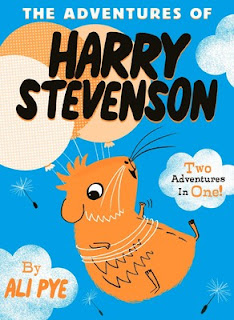"It was as if the air around the hotel was the colour of honey.
Some dream-like brew of sunshine and hope."
Vincent inherits a shoe shine kit from his grandfather. It seems to contain magic because on the first day, when Vincent sets up his shoe shine business at the market, he is spotted by Florence and his life changes forever. Florence invites Vincent to work at her hotel - the Grandest Hotel on Earth.
Florence is eleven, like Vincent, but she has an important and demanding job. She is in charge of the Grandest Hotel on Earth. When you read about this hotel I guarantee you will be desperate to stay there. Everything is utterly amazing and wonderful.
Here are some examples:
Rooms for guests as suggested by Rupert the concierge
The Inflatable Room
The Sparkles Room
Room of the Unexpected
Winter Wonderland Room
The African sky Room
The Anti-gravity Room
Le Pomme Frites Chambre - a small sliding door in the wall opens and you are presented with hot chips over and over again!
Transport
Tiny porter ponies "no bigger than medium-sized dogs - with spectacular feathered head-dresses and rainbow tails."
Jet Pack
Llama
Hot air balloon - the best way to arrive at the hotel
Extras
Every guest is given a pocket dog - Vincent names his Min.
There is an island with a colony of sloths. Guests can attend a "find you inner sloth class" at three pm.
Bowling alley, an ice rink and a roller ring
Enjoy a room full of pillows
Hot springs and slopes to Ski
Hang gliding and parachuting
In so many ways the Grandest Hotel feels just like the magic of Charlie and the Chocolate Factory but there is also a poignancy to this story. For Florence this is the burden of running the hotel and awaiting the return of her parents. She is lonely and longs for a friend. But it is Vincent who has the most serious problems. Life at home is terribly hard. His four year old brother cannot speak and seems to constantly scream. Vincent's mother and father spend all their time coping with Thom and it is difficult for Vincent not to feel resentful. The only way to calm Thom is to play classical music. If you read this book be prepared to find musical examples such as Bach's Cello suite No.1 in G Major and Eric Satie's Gymnopedie No1.
Can you see some links between Florence and Vincent? Yes they both need friends. Yes they both are burdened with adult responsibilities. Then we discover Florence wears beautiful emerald boots that play classical music and there are plenty of fresh eggs at the Grandest Hotel. I am sure you can see these connections too but of course things do not run entirely smoothly for Vincent. He discovers there is a room in the hotel called Mirrors of the Future. Vincent is desperate to discover the future especially in relation to Thom and his parents. Zelda (the classical pianist who entertains people inside the hotel lift) warns Vincent "we can undo some things Vincent, but we can never unsee them. Remember that."
Vincent does look in to the future room. Not just once but several times. My heart almost broke for Vincent as I watched him struggle with the impossible task, he now sets himself, of changing the future.
I have read other books about hotels but this is one of the best. If you read the Heartwood Hotel series and are ready for more advanced story then this is the book for you!
Other stories set in hotels for older readers include:
Withering-by-sea by Judith Rossell
Floors by Patrick Carman
The Fish in Room 11 by Heather Dyer
The Big Bazoohley by Peter Carey
Moles by Andrew Strong
Front Desk by Kelly Yang
Huge thanks to Beachside bookshop for my Advanced Reader Copy of Vincent and the Grandest Hotel on Earth. This book will be available from 2nd July, 2019.
I give this book five out of five stars - yes it is THAT GOOD!
"Vast and soaring, the lobby was the most magnificently beautiful room he had ever stepped foot in. It was a seamless blend of inside and outside, a treasure chest of man and Mother Nature's finest ..."



















































